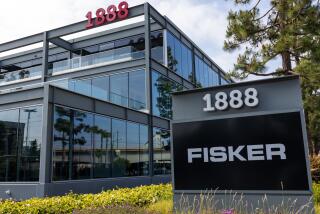Fisker used political connections to get loan, U.S. lawmakers say
- Share via
WASHINGTON — Top executives from failed hybrid car maker Fisker Automotive Inc. denied claims in Congress that the company had used political connections to secure $192 million in government loans to finance a flawed business plan.
The executives appeared Wednesday before Congress for the first time since the Department of Energy seized $21 million Fisker had remaining in an account April 11. The Anaheim company was approved for a $529-million loan in 2010 and received $192 million before getting cut off.
Fisker laid off most of its workers this month and is expected to file for bankruptcy. The company’s plan to build $100,000 plug-in hybrids was doomed from the start, conservative members of Congress said at the hearing.
“Fisker never oriented itself toward market signals and consumer demand,” said Rep. Jim Jordan (R-Ohio), chairman of the House Subcommittee on Economic Growth, Job Creation and Regulatory Affairs. “It’s north star was the political winds of Washington.”
Jordan said records showed the company’s connections within the Obama administration, the Department of Energy’s lending office and elsewhere allowed Fisker to secure loans — and then to avoid being cut off from loan disbursements after missing certain milestones.
Henrik Fisker, the Danish auto designer who founded the company, denied any improper political dealings.
“Let me be clear: I am not aware and do not believe that any improper political influence was used in connection with the company’s loan application or subsequent negotiations with the Department of Energy,” said Fisker, who recently resigned amid a management dispute at Fisker.
The company got the loans through a program Congress created in 2007 for green energy projects and technologically advanced vehicles.
Liberal subcommittee members framed Fisker’s losses as relatively minor when taken in context of the $35-billion program.
Rep. Gerald Connolly (D-Va.), compared Fisker’s attempts at innovation to those of Orville and Wilbur Wright, Thomas Edison and other American innovators, whose attempts, he noted, failed before they succeeded.
Liberal members also mentioned a string of misfortunes the company suffered, including the failure of lithium-ion batteries from manufacturer A123 Systems Inc. and the loss of 338 vehicles during Superstorm Sandy.
Ford, Nissan and Tesla also received loans under the 2007 program. Loans given to those companies financed electric and fuel-efficient cars and created jobs, former Department of Energy program director Nicholas Whitcombe told Congress.
Rep. Darrell Issa (R-Vista) acknowledged the general success of the loan program but said that did not exempt the Department of Energy from its decision.
“Quite frankly, innovative cars have a history of failing,” Issa said.
But Jordan said a loss of about $171 million in taxpayer money could not be explained away. When Fisker applied for the loan, the startup company had a lower credit rating than the larger motor companies and a “junk-grade” investment rating, and lacked collateral, he said.
Jordan and others asked how Fisker was allowed to keep drawing on the federal loan when it produced just a few hundred Karma models in 2011 — after planning to produce 14,000. Jordan said records showed the Department of Energy at one point lent money to the company after executives expressed concern they would not be able to make payroll.
One of the company’s founders and a chief executive, Bernhard Koehler, said he is still pursuing investors and intends to pay back the Department of Energy loan and continue work on another electric car model. He said the Karma model made strides in the electric hybrid field and was certified in the United States, Europe and Asia.
“The vision has become a reality,” Koehler said.
Twitter @wesventeicher
More to Read
Inside the business of entertainment
The Wide Shot brings you news, analysis and insights on everything from streaming wars to production — and what it all means for the future.
You may occasionally receive promotional content from the Los Angeles Times.










